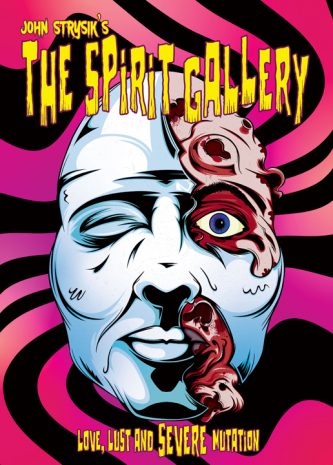 A 1995 feature that was apparently conceived as “THE PICTURE OF DORIAN GREY in reverse,” which fails to convey the sheer bizarrie of this sustained hallucination of a movie. It was shot on video, a fact I’m well aware will turn off many potential viewers, but THE SPIRIT GALLERY is actually among of the more technically accomplished such features, and no wonder: the writer-producer-director was John Strysik, who in 1995 was already a well-established filmmaker, having directed the acclaimed short films THE MUSIC OF ERICH ZANN (1980) and A HUNGER ARTIST (1982), as well as several episodes of TALES FROM THE DARK SIDE and a portion of the SOV anthology DARK ROMANCES.
A 1995 feature that was apparently conceived as “THE PICTURE OF DORIAN GREY in reverse,” which fails to convey the sheer bizarrie of this sustained hallucination of a movie. It was shot on video, a fact I’m well aware will turn off many potential viewers, but THE SPIRIT GALLERY is actually among of the more technically accomplished such features, and no wonder: the writer-producer-director was John Strysik, who in 1995 was already a well-established filmmaker, having directed the acclaimed short films THE MUSIC OF ERICH ZANN (1980) and A HUNGER ARTIST (1982), as well as several episodes of TALES FROM THE DARK SIDE and a portion of the SOV anthology DARK ROMANCES.
Lensed in June 1991 on location in San Francisco, THE SPIRIT GALLERY was made (according to its assistant director Corey Sienega) because Strysik had “been out of work for a while, had a script and fell into some sort of recent inheritance.” The pic received very little attention (outside a 1991 Film Threat Video Guide article by Sienega), with its long-belated DVD release occurring in October of 2019. Also featured on the DVD is YOUNG PEOPLE IN TROUBLE, a 1970s short film by Strysik that evinced an early manifestation of the interest in surrealism and fringe culture showcased in THE SPIRIT GALLERY.
The story: A devoutly religious San Franciscan named Gwendolyn Creed finds herself drawn to the art of B.A. Catch, a reclusive individual known for his “Art of Goodness” that has apparently deadly side effects. Gwendolyn gets a job as an assistant to Catch’s slimy agent Gideon Haul, and at a party one night actually catches a glimpse of Catch, pursuing him through some of the scuzzier corners of San Francisco’s red light district.
In the meantime Gwendolyn finds herself afflicted by odd dreams and hallucinations involving featureless white facial masks and a deserted factory. The latter, it transpires, is an actual location where Catch resides. Haul takes Gwendolyn there, and she finally meets her idol—who initially seems quite unimpressed by her. Following more odd dreams/hallucinations she heads back to the factory, where Catch finally agrees to paint her portrait and she gets a good look at his retinue of Hieronymus Boschian paintings (actually the work of San Francisco artist/videographer Frank Garvey).
The portrait painting goes reasonably well, at least until Catch takes Gwendolyn to the “Spirit Gallery.” There she (and we) learn how Catch really creates his portraits: by conjuring up a mass of ectoplasm with which he covers the faces of his subjects and literally steals their souls. This causes Gwendolyn to break out in severe skin lesions every time someone looks at the sculpture Catch has made from the ectoplasm. There’s no cure, it seems, for the malady, although Catch is moved to at least try something new: a self-portrait. The results are unexpected, to say the least.
This being a no-budget shot-on-video production, one must be forgiving of the non-professional acting and synthesizer score (the one element that really dates the film). Again, though, this is one of the slicker SOV productions I’ve seen, with some imaginative visual compositions, a terrifically inventive script and well-chosen San Francisco locations (viewers of Frank Garvey’s surreal SOV opus FEEDING FRENZY will notice the factory setting from that film, as well as its lead actor Jim Burkhart, who plays Catch).
Plus, unlike seemingly every other SOV horror film of the decade, Strysik doesn’t overload the proceedings with gratuitous nudity and gore (although there is plenty of the latter on display). Strysik’s aims are far more thoughtful and abstract, involving art, spirituality and the work of Luis Bunuel (who Strysik references repeatedly in his DVD commentary). Those concerns come together in the innumerable hallucinatory interludes that in true Bunuel fashion are freely enmeshed with “reality,” and also the finale, an insane mélange of elaborate SOCIETY-like mutation effects by make-up artist Rodd Matsui (also a director on DARK ROMANCES) that’s astounding by any conceivable standard.
Vital Statistics
THE SPIRIT GALLERY
Number Sign Productions
Director/Producer/Screenwriter: John Strysik
Cinematography: Sue Coburn
Editing: Sam M. Oldham
Cast: Holly Riddle Zuniga, Jim Burkhart, Leonard Parnell, Gilbert Pickett, Nell Schwartz, Frank Garvey, John Strysik
